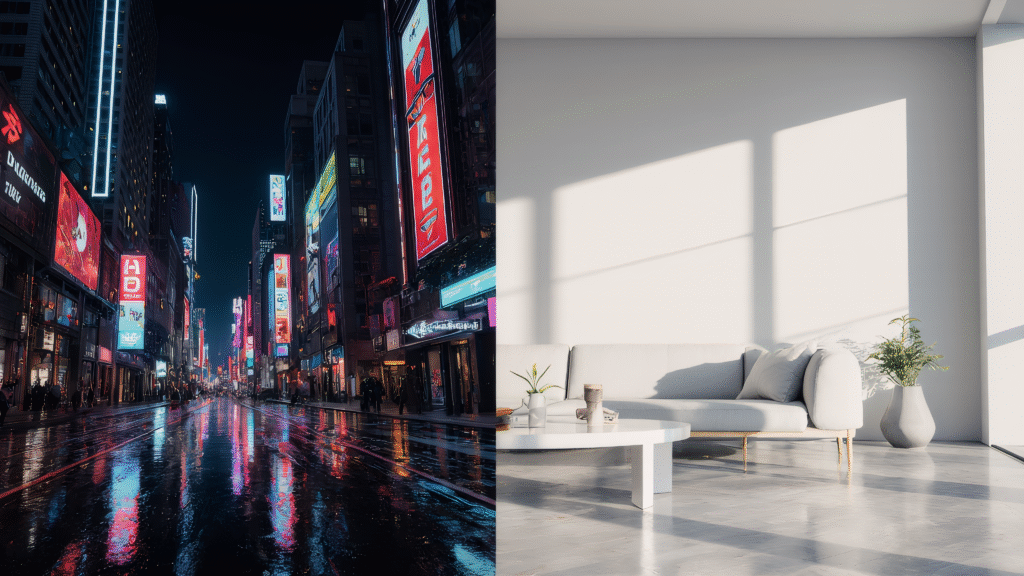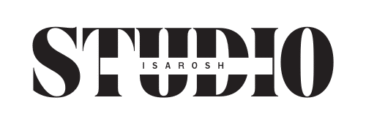The way we see and experience design is evolving at lightning speed. Walk through a city today, and you might feel caught between two worlds: glowing cyberpunk billboards lighting up the skyline, and serene minimalist interiors trending across social feeds. In 2025, this collision of aesthetics isn’t just a passing phase — it’s defining how brands, creators, and audiences connect visually.
From neon-drenched cityscapes to the quiet elegance of white space, the fusion of extremes is rewriting the rules of style. It’s no longer about choosing one path; it’s about blending contrasts into something new, bold, and memorable. Whether you’re a designer, a content creator, or simply someone who loves fresh ideas, the trends ahead will reshape how we communicate through visuals.

Cyberpunk’s Glow: The Return of Neon
Picture this: a rainy evening in the city, the streets glistening like glass, and towering neon signs in hot pink, blue, and violet reflecting off the wet asphalt. It feels like you’ve just stepped into a futuristic movie scene. That’s exactly why cyberpunk aesthetics are making such a strong comeback — they don’t whisper, they shout.
Neon is trending because it demands attention. In a world where our feeds are crowded with endless content, those glowing colors cut through the noise. Brands use neon not only to stand out visually but also to spark emotion — drama, energy, and even a little nostalgia for the sci-fi visions of the past.
But it doesn’t stop at social media. Neon-inspired visuals are slipping into packaging design, music videos, motion graphics, and even event staging. Anywhere a creator wants to deliver an “electric” experience, neon is the natural choice.
Minimalism Evolved: Less Noise, More Impact
On the other end of the spectrum, minimalism is still thriving — but it has matured. No longer just black text on white backgrounds, 2025 minimalism embraces subtle gradients, elegant typography, and clean 3D visuals.
It’s all about breathing space. Amid digital chaos, audiences crave simplicity and clarity. Minimalism delivers calmness and focus, making it the go-to choice for personal brands, portfolio websites, and editorial content.
The Fusion of Styles: Contrast as a Creative Tool
Here’s where things get exciting: designers are no longer choosing one extreme. They’re blending cyberpunk’s vibrancy with minimalist clarity to create striking contrasts. Imagine a clean, white landing page with one glowing neon accent that pulls the eye instantly — that’s the new language of design.
This mix works because it plays with emotions: energy + calm, chaos + order. It reflects the real world, where people juggle fast-paced lives while seeking balance.
3D Visuals and Motion: Static is Out
The age of static visuals is fading fast. In 2025, audiences crave content that feels alive — graphics that move, shift, and immerse them in a story. What was once considered a “nice extra” is now an expectation: 3D design, animation, and motion effects are part of the new visual standard.
For businesses, this shift is more than an aesthetic choice. A real estate agency showcasing properties with 3D walkthroughs instantly gives buyers a sense of space. E-commerce brands use motion to highlight product features, making online shopping more engaging and persuasive. Even corporate presentations are evolving — a sleek animated graph says more than a static bar chart ever could. Motion helps businesses not just show their message but make people feel it.
Graphic designers, too, are stepping into a new era. In the gaming industry, 3D visuals are no longer just a perk — they’re the foundation of immersive worlds. Consoles and VR platforms thrive on environments that feel real, dynamic, and endlessly explorable. Demand for designers who can craft these experiences is at an all-time high. The same goes for architecture: 3D renderings let clients “walk through” a building before a single brick is laid, saving time, costs, and misunderstandings. It’s visualization turned into foresight.
In everyday life, these tools are making their way into education, marketing, and even social media. Think of a fitness app that demonstrates workouts with 3D motion, or a furniture brand that lets you virtually place a sofa in your living room. These aren’t gimmicks; they’re becoming part of how we interact with products, brands, and spaces.
Static design may still have its place, but motion is what brings energy, depth, and meaning. For businesses, creators, and consumers alike, 3D isn’t just the future — it’s the language of the present.
Why This Matters for Creators and Businesses
Visual trends aren’t just about looking cool. They directly influence how people perceive brands and messages. A strong visual direction can:
-
Capture attention in crowded feeds.
-
Build emotional connection faster than words.
-
Signal innovation, professionalism, and style.
Whether you’re running a digital studio, building a personal brand, or marketing products online, understanding these shifts helps you stay ahead of the curve.
2025 isn’t about choosing between cyberpunk or minimalism — it’s about embracing both, and everything in between. The future of visuals lies in contrasts, bold fusions, and storytelling through design.
So next time you’re designing a post, a video, or even a product package, ask yourself: what happens if I blend neon energy with minimalist calm? Chances are, you’ll create something unforgettable.
👉 Ready to explore more creative directions? Stay tuned to our blog — we’ll keep breaking down the trends shaping tomorrow’s digital world.
